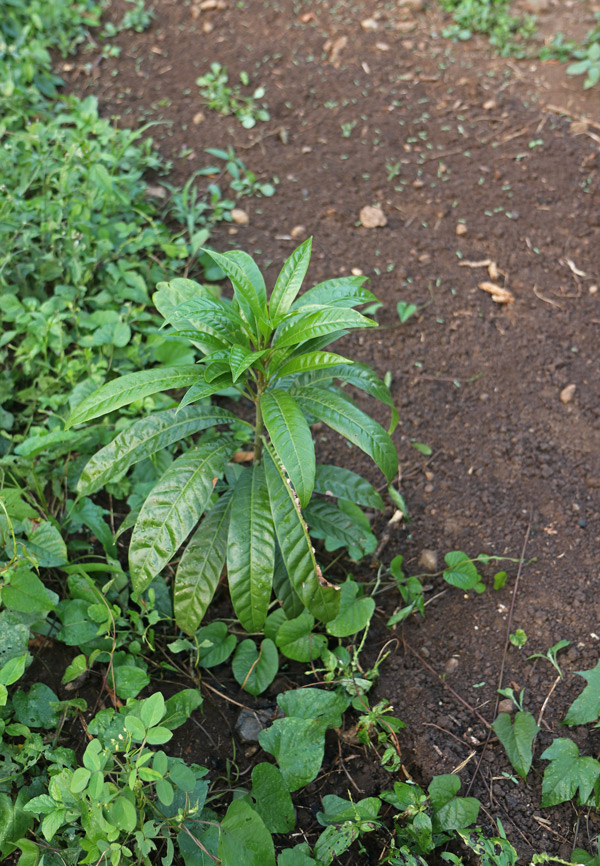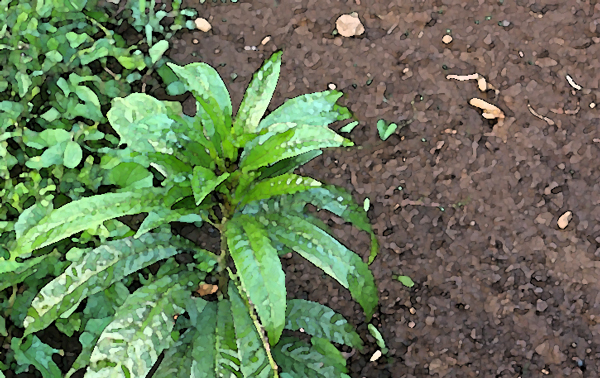My friend Farah was able to get me a single canistel seed last year after I met her at the Rare Fruit and Vegetable Council of Broward County.
I planted it immediately when I got home, then nothing happened for a couple of months.
Eventually, I decided to dig it up to see if the seed was rotten… and lo and behold, there was a long root on it, which I partly broke in my digging!
I carefully re-buried the seed and prayed it would live, kicking myself for my impatience. A month or so later, a sprout emerged and a tree started to grow.
A few months later, when we moved to our land, I planted the tree over the body of my children’s deceased pet rabbit:
And now, it’s really starting to grow and put on new leaves:

Canistel is a wonderful fruit with a unique and rich flavor.
“The fact that the canistel is not crisp and juicy like so many other fruits seems to dismay many who sample it casually. Some take to it immediately. During World War II when RAF pilots and crewmen were under training in the Bahamas, they showed great fondness for the canistel and bought all they could, find in the Nassau market.
Some Floridians enjoy the fruit with salt, pepper and lime or lemon juice or mayonnaise, either fresh or after light baking. The pureed flesh may be used in custards or added to ice cream mix just before freezing. A rich milkshake, or “eggfruit nog”, is made by combining ripe canistel pulp, milk, sugar, vanilla, nutmeg or other seasoning in an electric blender.
The late Mrs. Phyllis Storey of Homestead made superb ‘mock-pumpkin” pie with 1 1/2 cups mashed canistel pulp, 2/3 cup brown sugar, 1/2 teaspoon salt, 1/4 teaspoon nutmeg, 1 teaspoon lime juice, 2 beaten eggs, 2 cups evaporated milk or light cream. The mixture is poured into one crust and baked for 1 hr at 250º F (121º C).
Others have prepared canistel pancakes, cupcakes, jam, and marmalade. Mrs. Gladys Wilbur made canistel “butter” by beating the ripe pulp in an electric blender, adding sugar, and cooking to a paste, with or without lemon juice. She used it as a spread on toast. The fruit could also be dehydrated and reduced to a nutritious powder as is being done with the lucmo (q.v.) and this might well have commercial use in pudding mixes.”
I have another canistel growing at my parents’ house in Ft. Lauderdale; however, it has grown slowly and has not borne fruit after 8 years of growth. I believe this is due to poor soil and intermittent watering. It’s also surrounded by grass, which reduces the resources available to the roots.
I need to weed and mulch around my little tree to keep it happy. It’s already getting plenty of water and fertilizer by being near the gardens. I planted it close so we’d keep an eye on it. So far as I know, it’s the only tree for miles.


2 comments
[…] post The Little Canistel That Could appeared first on The Survival […]
What country are you located? is it costa rica or bali?
Comments are closed.